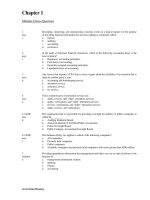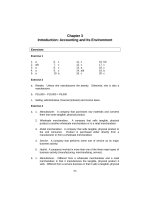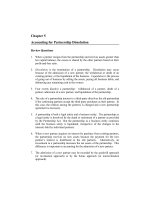Solution manual fundamentals of accounting by cabrera chapter 03 SM
Bạn đang xem bản rút gọn của tài liệu. Xem và tải ngay bản đầy đủ của tài liệu tại đây (102.32 KB, 7 trang )
Chapter 3
Accounting for Partnership Formation and Operating
Transactions
Review Questions
1. The current market value of the assets contributed to a partnership
determines the amount of the credit to the partner’s capital account.
2. Partner withdrawals of cash for personal use do not affect the sharing of
profits and losses by the partners. Their shares of profits and losses are based
on the profit-and-loss ratio, which is determined separately from their cash
withdrawals.
3. Fair market values represent the realistic worth of the assets invested. This
means that if these assets were to be purchased at their particular date, they
are being turned over to the partnership, the amount that would be needed is
equivalent to the value determinable as of that date.
4. A written partnership contract is highly desirable to have a clear and definite
basis in operating a partnership. Future disagreements and confusion will be
avoided. The matters to be included in a typical partnership contract are
found on pages 51-52. The accountant can use the contract in the recording
of transactions involving financial matters such as the partners’
(a) investment and drawings
(b) sharing of income or loss.
The contract will also be used as reference in determining the accounting
period to be used, the nature of accounting records, financial statements,
audit and so forth.
5. To have a separate and distinct accounting for each partner’s investment and
drawings.
6. Noncash investments of partners should be recorded at their fair values in
order to provide equitable treatment to the individual partners. The recoding
of noncash assets at less than fair value will result in allocating the amount of
understatement between the partners in their relative profit and loss sharing
2
Chapter 3
ratios as the undervalued assets are used for partnership business or when
they are sold by the partnership.
7. Conceptually, there is no difference between the drawings and the
withdrawals of partners since both represent disinvestments of resources
from the partnership entity. From a practical viewpoint, the distinction
between withdrawals and drawings may be important because allowable
drawings are not usually deducted in determining the amount of partnership
capital to be used for purposes of dividing profits among the partners. Since
withdrawals are deducted, the distinction can affect the division of profits
and losses.
8. Three kinds of transactions affect the capital account of any partner:
investments, withdrawals, and periodic closings of income, expense, and
drawing accounts.
9. Capital invested represents permanent investment in the partnership and will
only be returned to the partners upon withdrawal and liquidation of the
partnership while loan represents resource made available to the partnership
but which is expected to be repaid at some future date.
10. Cash
Land
5,000
7,500
X, Capital
Y, Capital
5,000
7,500
The amounts used represent the fair value of the assets being invested in the
partnership.
11. To have a realistic and fair valuation of the assets to be transferred to the
partnership.
12. Refer to page 63 of the textbook.
Accounting for Partnership Formation and Operating Transactions
3
Exercises
Exercise 1
Cash
Delivery Equipment
Cruz, Capital
Gomez, Capital
200,000
75,000
100,000
175,000
Exercise 2
Cash
Land and Building
Tools and Machinery
Accounts Payable
Tamano, Capital
Santos, Capital
50,000
300,000 *
80,000 **
30,000
330,000
70,000
* Should be allocated between land and building based on their fair market value.
** Should be allocated between tools and machinery based on fair market value or
acquisition cost.
Exercise 3
Cash
2,100
Accounts Receivable
10,600
Office Furniture (P2,700 – P1,100)
1,600
Building
71,000
Allowance for Uncollectible Accounts
Accounts Payable
Note Payable
Accrued Expenses Payable
Torres, Capital
To record Torres’ investment in the partnership.
Exercise 4
2,900
3,300
10,000
1,200
67,900
4
Chapter 3
Cash
Merchandise inventory
Accounts receivable
Store equipment and fixtures
Allowance for uncollectible accounts
Accumulated depreciation
Benet, Capital
Abad, Capital
200,000
160,000
20,000
40,000
15,000
24,000
200,000
181,000
Exercise 5
Cash (25,000 + 30,000)
Accounts receivable (150,000 + 100,000)
Supplies inventory (199,500 + 161,500)
Notes receivable
Interest receivable
Furniture, fixtures and equipment (95,000 + 70,000)
Accumulate depreciation – furniture, fixtures
and equipment (19,000 + 14,000)
Allowance for bad debts (15,000 + 10,000)
Accounts payable (185,000 + 160,000)
J. Joven, capital
B. Burgos, capital
55,000
250,000
361,000
45,000
400
165,000
33,000
25,000
345,000
250,500
222,900
Exercise 6
Cash (19,000 + 86,600)
Accounts receivable
Notes receivable
Interest receivable
Merchandise inventory
Store equipment
Allowance for bad debts
Accumulated depreciation – store equipment
Accounts payable
X, capital
Z, capital
Test Materials
105,600
85,000
30,000
200
122,000
35,000
12,750
12,250
93,000
173,200
86,600
Accounting for Partnership Formation and Operating Transactions
5
Test Material 3-1
If the partners’ contributions were erroneously recorded at cost rather than fair
market value, the account balances would be:
Cash
Delivery equipment
Furniture inventory
P 30,000
40,000
60,000
P130,000
Kitty, capital
Snoopy, capital
P 70,000
60,000
P130,000
Inequity is calculated as follows:
Snoopy’s appreciation
Kitty’s depreciation
(P30,000)
(P10,000)
Actual appreciation
Inequity
60% to
Snoopy
P18,000
(6,000)
12,000
30,000
(18,000)
40% to
Kitty
P12,000
(4,000)
8,000
(10,000)
18,000
Total
P30,000
(10,000)
20,000
20,000
0
Test Material 3-2
Capital balance per books for each partner is equal to the fair market value of
contributed net assets:
Assets contributed to partnership
Liabilities assumed by partnership
Capital balance per books
Test Material 3-3
Ju
P162,000
(41,000)
P121,000
Yoon
P66,000
(28,000)
P38,000
6
Chapter 3
Requirement (1)
GENERAL JOURNAL
Date
March 15
15
Accounts and Explanation
Accounts Receivable
Inventory
Prepaid Expenses
Store Equipment
Allowance for Doubtful Accounts
Accounts Payable
Lazo, Capital
To record Lazo’s investment
in the partnership.
Post
Ref
Debit
12,000
31,220
2,400
26,600
Credit
1,360
22,300
48,560
Cash
48,560
Roman, Capital
To record Roman’s
investment in the
partnership.
48,560
Requirement (2)
Roman and Lazo
Statement of Financial Position
March 15, 20xx
ASSETS
Cash
Accounts receivable
P12,000
Less: Allowance for
doubtful accounts 1,360
Inventory
Prepaid expenses
Store equipment
Total assets
Test Material 3-4
LIABILITIES
P 48,560
Accounts payable
10,640
31,220
2,400
26,600
P119,420
CAPITAL
Roman, capital
Lazo, capital
Total liabilities and
capital
P 22,300
48,560
48,560
P119,420
Accounting for Partnership Formation and Operating Transactions
7
Requirement (1)
GENERAL JOURNAL
Date
June
30
30
Accounts and Explanation
Accounts Receivable
Inventory
Prepaid Expenses
Office Equipment
Allowance for Doubtful Accounts
Accounts Payable
Azures, Capital
To record Azures’
investment in the
partnership.
Post
Ref
Debit
7,200
24,100
1,700
27,600
Credit
1,050
19,100
40,450
Cash
40,450
Roca, Capital
To record Roca’s investment
in the partnership.
40,450
Requirement (2)
Azures and Roca
Statement of Financial Position
June 30, 20xx
ASSETS
Cash
Accounts receivable
P7,200
Less: Allowance for
doubtful accounts 1,050
Inventory
Prepaid expenses
Office equipment
Total assets
LIABILITIES
P 40,450
Accounts payable
6,150
24,100
1,700
27,600
P100,000
CAPITAL
Azures, capital
Roca, capital
Total liabilities and
capital
P 19,100
40,450
40,450
P100,000









